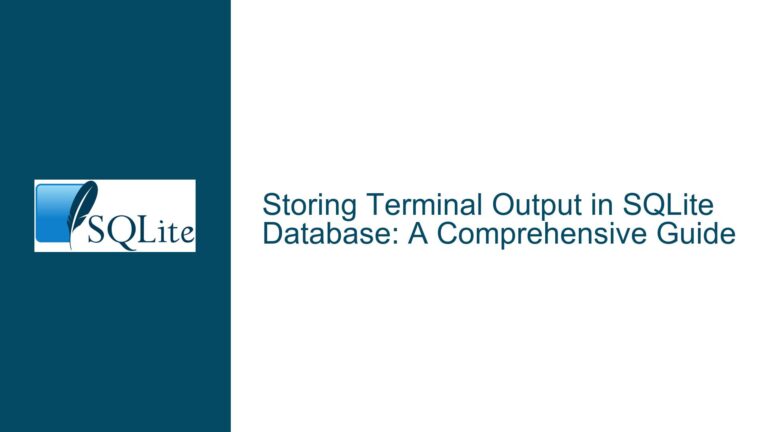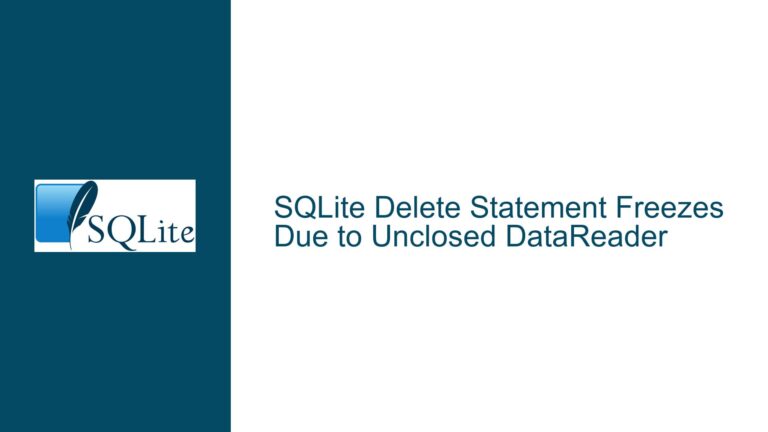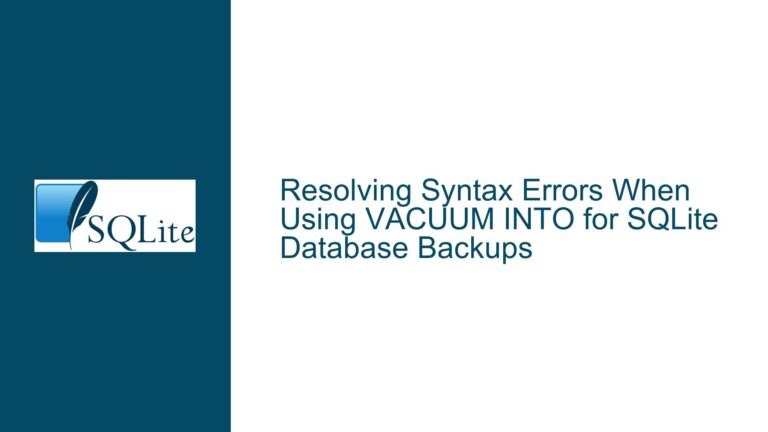Limiting SQLite CSV Imports to Specific Number of Lines
Importing Large CSV Files for Testing Purposes
When working with large CSV files in SQLite, it is often necessary to import only a subset of the data for testing or preliminary analysis. This is particularly useful when dealing with files that are several gigabytes in size, where importing the entire dataset would be time-consuming and resource-intensive. The primary goal in such scenarios is to quickly examine the structure of the data, including the headers and the initial rows, without committing to a full import.
The SQLite command-line interface (CLI) provides a convenient .import command for importing CSV files into tables. However, this command does not natively support limiting the number of rows imported. As a result, users often resort to external tools like head in Unix-based systems to truncate the file before importing. While this workaround is effective, it introduces an additional step in the workflow, which can be cumbersome, especially when dealing with multiple files or when the process needs to be repeated frequently.
The absence of a built-in row-limiting feature in the .import command can be attributed to the nature of SQLite’s design, which emphasizes simplicity and minimalism. SQLite is designed to be a lightweight, serverless database engine, and as such, it avoids incorporating features that could complicate its core functionality. However, this design philosophy can sometimes lead to gaps in functionality that users must address through external tools or custom scripts.
Ambiguity in Row Order and Foreign Key Constraints
One of the challenges associated with limiting the number of rows during a CSV import is the potential ambiguity in row order. In relational databases, the order of rows in a table is generally considered irrelevant, as the data is typically accessed through queries that specify conditions and sorting criteria. When importing a CSV file, the order of rows is determined by the file itself, and there is no guarantee that the first N rows will be representative of the entire dataset.
This issue becomes more pronounced when dealing with multiple CSV files that are linked through foreign key constraints. In such cases, the first N rows of one table may not correspond to the first N rows of another table, leading to referential integrity issues. For example, if you are importing data from two related tables—orders and order_items—the first 1000 rows of the orders table may not have corresponding entries in the order_items table if the rows are not aligned. This misalignment can result in orphaned records or violated foreign key constraints, which can complicate data analysis and testing.
The logical solution to this problem is to apply the row limit at the level of CSV file preparation rather than during the import process. By pre-processing the CSV files to ensure that the first N rows are meaningful and consistent across related tables, you can avoid issues related to row order and foreign key constraints. This approach requires additional effort upfront but ensures that the imported data is coherent and suitable for testing purposes.
Implementing Row Limits with External Tools and Custom Scripts
Given the limitations of the SQLite .import command, users often turn to external tools and custom scripts to implement row limits during CSV imports. One common approach is to use command-line utilities like head or sed to extract the first N rows from a CSV file before importing it into SQLite. For example, the command head -n 1000 data.csv > data_sample.csv can be used to create a new file containing only the first 1000 rows of the original CSV file. This truncated file can then be imported into SQLite using the .import command.
While this method is straightforward, it has several drawbacks. First, it requires manual intervention, which can be error-prone and time-consuming, especially when dealing with multiple files. Second, it does not address the issue of foreign key constraints, as the truncated files may still contain inconsistent data. Finally, this approach is not easily scalable, as it becomes increasingly cumbersome to manage as the number of files and the complexity of the data grow.
A more robust solution is to use a custom script to pre-process the CSV files and ensure that the row limits are applied consistently across related tables. For example, a Python script could be written to read the first N rows from each CSV file, validate the data against foreign key constraints, and generate new CSV files that are ready for import. This approach provides greater flexibility and control over the import process, allowing you to handle complex data relationships and ensure data integrity.
Below is an example of a Python script that limits the number of rows imported from a CSV file and ensures that foreign key constraints are respected:
import csv
import sqlite3
def limit_csv_rows(input_file, output_file, limit):
with open(input_file, 'r') as infile, open(output_file, 'w') as outfile:
reader = csv.reader(infile)
writer = csv.writer(outfile)
for i, row in enumerate(reader):
if i >= limit:
break
writer.writerow(row)
def import_csv_to_sqlite(csv_file, table_name, db_file):
conn = sqlite3.connect(db_file)
cursor = conn.cursor()
with open(csv_file, 'r') as file:
reader = csv.reader(file)
headers = next(reader)
cursor.execute(f"CREATE TABLE IF NOT EXISTS {table_name} ({', '.join(headers)})")
cursor.executemany(f"INSERT INTO {table_name} VALUES ({', '.join(['?']*len(headers))})", reader)
conn.commit()
conn.close()
# Example usage
limit_csv_rows('data.csv', 'data_sample.csv', 1000)
import_csv_to_sqlite('data_sample.csv', 'my_table', 'my_database.db')
This script first limits the number of rows in the CSV file and then imports the truncated file into an SQLite database. While this example is simplistic, it can be extended to handle more complex scenarios, such as validating foreign key constraints or processing multiple related CSV files.
In conclusion, while SQLite does not provide a built-in way to limit the number of rows imported from a CSV file, there are several effective workarounds available. By using external tools or custom scripts, you can achieve the desired functionality while maintaining data integrity and consistency. These solutions require additional effort but offer greater flexibility and control over the import process, making them invaluable for testing and preliminary data analysis.






